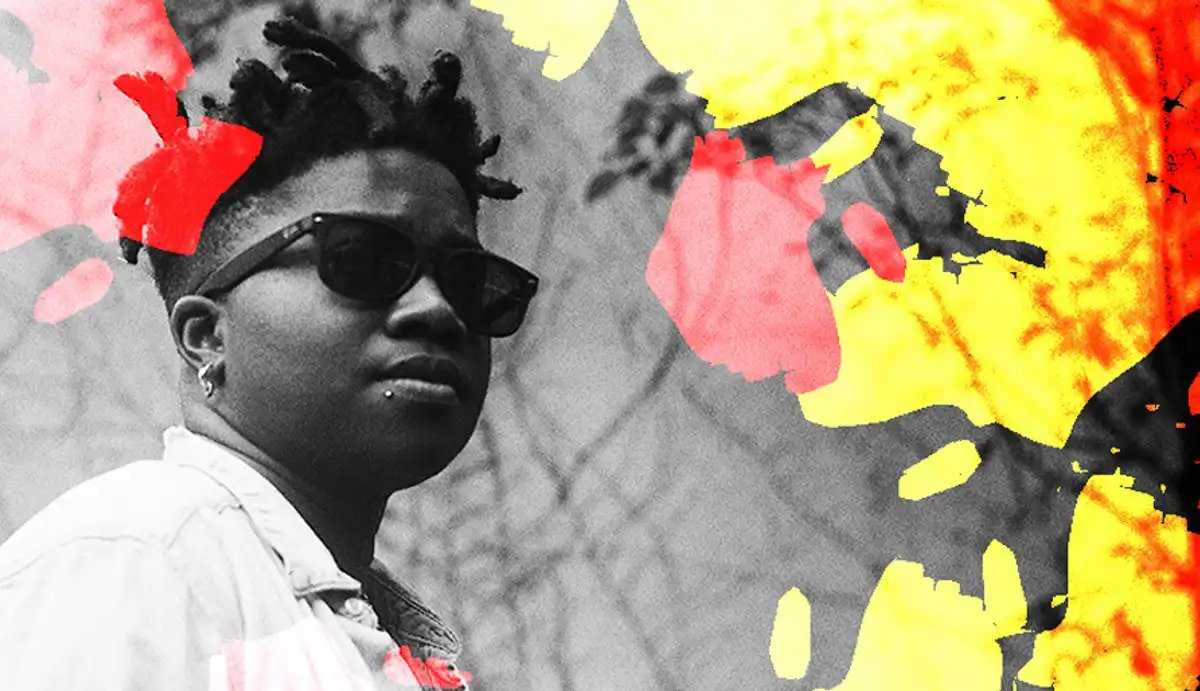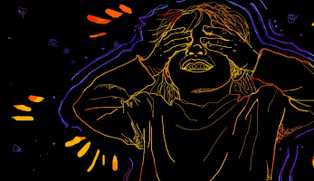Tiona McClodden is a filmmaker and visual artist whose work deals with issues of social change, social realism, nostalgia and (re)memory within the African diaspora. She is the recipient of the 2016 Pew Fellowship in the Arts in Philadelphia and most recently completed a residency at the newly established The Center for Afrofuturist Studies in Iowa. Her multimedia project Affixing Ceremony: Four Movements for Essex will be featured in Skin Deep’s upcoming 5th print edition: IMAGINING 2043. Skin Deep had a chance to interview Tiona. Here is our conversation.
*
Skin Deep: What is your first memory? Tiona McClodden: One of my earliest memories is trying to take a photo of myself with a camera with the flash on. I have the photo to this moment actually. My mom was getting her hair done at a beauty salon in London where my father was stationed at RAF Lakenheath at the time. SD: Remembrance as a ritual and ceremony is a concept that you introduce by way of Toni Morrison in your work Affixing Ceremony: Four Movements for Essex, in which you are in conversation with the works of the late gay American poet and activist Essex Hemphill. You “affix” him in cyberspace, a theme he explored in a statement titled “On the Shores of Cyberspace” that he delivered at a Black Nations/Queer Nations? conference. Why did you choose Hemphill as a subject of inquiry? TM: I actually affix the original essay written by Dr. Charles Nero, titled Fixing Ceremonies, which is the introduction to the second edition of Essex Hemphill’s book of poems and prose: Ceremonies. I think that the quote from the presentation he gave at the Black Nations/Queer Nations? conference was timely and actually contained a series of questions that I thought I could potentially explicate with the use of his body of work. Hemphill is a Black Gay icon that I literally have less than a degree of separation from posthumously. I know many of the people that I interviewed for the audio section of the project and had heard quite a bit about him over the years. He is also just a brilliant wordsmith and performer, so choosing to focus the project on him was a chance to investigate his life and work more deeply on the occasion on the 20th year since his death. SD: The notions of ceremony or perhaps ritual are clear in the work about Essex Hemphill, but also in the ‘keel laying’ ceremony of your performance KILO | Iba se 99. Does your filmmaking feel ceremonious? Is there a mirroring ritual for yourself as a filmmaker when engaging with such content? TM: The process of making my films is somewhat separate from what I’m trying to get across oftentimes. What I can say is that I really do strive for a level of intimacy in the production of my work and am very much anti-crew since I film a lot outside and want to be subversive in my filming. The objects on the other hand definitely get me closer to the form of ritual, which is why I have made a solid run at being a sculptor and juxtaposed those works with the films. I think KILO | Iba se 99 – which was produced with just me shooting and my lead performer Ash Tai on site at the perimeter of the naval yard – was as close to the idea of ritualistic filmmaking as I’ve gotten. Many of the shots, especially with her engraving the keel, were one-shot takes so there was a lot on the line. It was also freezing cold and we had limited time before it became dangerous. The ritual in the film of saluting the keel is a direct mirror or reflection of myself and my spiritual practice, almost a way to insert myself within the work. SD: You were an artist in residence at The Center for Afrofuturist Studies (CAS) in May of 2016. It’s a recent initiative started by Anaïs Duplan at a time when Afrofuturism has become a bit of a buzzword.Yet your work is incredibly retrospective, dealing with issues like nostalgia and involving a great deal of archival research. What is your conception of Afrofuturism and how do you feel that your work fits in with that particular artistic movement? I actually am not really down with the buzzword and “buzz-work” that is being produced under the theme or idea of Afrofuturism. I don’t think much of the work is genuine or even thinking seriously of what Afrofuturism will mean to the culture of Black aesthetics in the actual future. I think that my work deals with the elements of the movement in regards to one of the areas that have been neglected: the spiritual element. I do not think that Afrofuturism, as it is often presented, is purely science fiction or speculative fiction in aesthetics or concept. If anything, I am more invested in the mundane, how that perspective navigates certain time periods whether past, present or future. My work is about engaging with ideas and concepts of spirit and narrative within concepts of Black survival and technologies related to share ideas of the African Diaspora. What I like about the way that Anaïs (the founder of CAS) framed the residency was the openness to the term and idea. She said “I really don’t know what it is and am not really seeking to make a firm statement on it” which I liked, so I felt really confident to come and work out some very difficult ideas around work that I could actually produce in the week that I was there. I ended up producing four new works that I had been doing the researching for leading up to the residency. Each work dealing with past and present with an investment in concepts related to futurity. SD: As a filmmaker, you’re quite a visual person and engaged in understanding the affects and impacts of images, whether they be moving or still. Yet recently, in your project The Chills, you’ve started to focus on sound as a medium that influences how we react and dis/remember things. Has this sensoria shift l from the visual to the sonic shift impacted the way that you understand and reflect on past events and help you anticipate the future? TM: The Chills was about my interest in creating an obstruction for myself in regards to how I have been producing work: primarily visual. This was my first sound work and was based on my interest in Autonomous Sensory Meridian Response (ASMR) which was about trying to create physical sensation of memory within my own body. I think that the shift in sensoria definitely expanded how I approached the use of sound in KILO, as that piece included archival sounds from documentaries produced on the workforce in WWII. With KILO, I asked my composer to produce the score before I shot the film, so the sound provided a vibe and lead-in for how I would form the work. Sound was something that I felt that I neglected in the past and definitely came into an understanding of how to situate within my artistic practice moving forward. SD: Invisibility is a theme that features quite prominently in “KILO | Iba se 99”, a work in which you explore the labour of black women in the navy, and the third movement in “Affixing Ceremony: Four Movements for Essex”. At one point you ask, “Can invisible men see their own reflections?”. Which is an interesting question and a question that writers like Ralph Ellison, in his book The Invisible Man, have posed before. Do you think there is something about being black that lends itself to invisibility? TM: I think there is something in being not only Black but Black-queer with a multiplicity of identities that can lend themselves to erasure. In general,I think most folks are interested in portioning individuals of their whole lived experiences. I think that there is an unhealthy push and investment by some to partition identities for how one navigates society and the world. My personal interest for the time that I have on this planet is to push for a full self in my work and life as an artist.with KILO it was about highlighting the Black women who worked on the Brooklyn Navy Yard during WWII, as many of their narratives have been erased and whitewashed. I wanted to answer the question that Essex poses with a living writer and performer producing transgressive work in this day and time who also lives and works in Philadelphia, where Essex produced work towards the end of his life. This movement in the work was about presence and life, like the proof of visibility and negotiation of identity. SD: In your epic film Be Alarmed: The Black Americana Epic in which an epic narrative is presented in short sections, many of which are trailers – it seems that the ‘epic’ is paradoxically becoming digestible. How do you juggle these ideas of genre? Do you feel the internet is freeing in that sense? (Perhaps in a similar way to how it has enabled epic tv dramas?) I think the internet opened up a new way to approach the concept of seriality in video/film and various art forms-a chance, allowing us to push things further and disrupt the form in general. The idea or form of the digital edition based delivery of something is what I am interested in. I also think that it is overwrought with brevity due to the short attention spans of users. I think the internet challenges me to defy genre. I remember life before the internet and am affected by both the limitations and freedoms that the internet provides especially in regards to distribution. The internet is a complicated space, because it also can be the container of illegal distribution of works as well. I think that I am interested in both collapsing and breaking apart genre in relationship to my work. With Be Alarmed, I’m also creating objects that serve as character extensions within themselves in the film. I’m thinking of film and narrative and object in conversation with genre and what that may mean or not to the delivery of an epic. SD: The way in which you discuss time, as a concept that involves the intersection of the past, present and future, along with what you describe as ‘intersubjectivities’ resembles durational art practice, recalling the ideas of artists such as Tehching Hsieh. Yet you simultaneously touch on personal notions of nostalgia and re-memory, which feel particularly psychological – re-memory for instance seems to bear similarities to Freud’s Nachträglichkeit or Afterwardsness. Do you feel that this is something you challenge in your work, time as it is in movement and as it is when experienced? I think I’m more invested in the psychological concept of cognitive dissonance as it relates to my work, and in regards to the tone that I hope that is imparts onto the audience once the work is installed for exhibition. While I’m aware of Afterwardsness, it is often tied to trauma, which is something I am not invested in within the production of my work. I think my interest in the intersection of the past, present, and future allows me a way to traverse nostalgia. I think that my interest in nostalgia is a fine line and that can be derailing if I don’t reel it in at times. Nostalgia is hypnotizing and seductive, and also can be very dangerous and blinding. I’m always trying to defy the sweet shit-to go deeper and to disrupt or make a new statement. My point of entry to the concept of re-memory is from Toni Morrison’s framing of it as “remembering a memory” and how she explicated this within her narrative Beloved as well as many of her other works. I think in reading Morrison’s work then provided space for me to take the recollections of my family and their history in relationship to their memories of family that I never had a chance to meet. For example, my grandmother on my mother’s side passed away when my mom was 16, so I never got the chance to meet her in the flesh, but I’ve met her through my mother’s memory of her and through images of her. On the other side of nostalgia I’m also interested in premonition and epiphany. As of recent I’ve read Yaa Gyasi’s debut novel Homegoing where she writes of premonition being a “forward memory” which I think is stunningly accurate. I reference writers because the foundation for most of my work comes from text, both fiction and archival non-fiction, as it is what I’ve had available to me early on as a kid and as someone who had access to galleries and museums much later than the average artist. SD: Are there any upcoming projects you are especially looking forward to or that we should look out for? I have an exhibit in August at the IceBox Project Space which will be a new organization of Movement I of my Be Alarmed series curated by Kate Kraczon, Associate Curator at Institute of Contemporary Art here in Philadelphia, PA. I will also be a fellow at this year’s Sommerakademie at Zentrum Paul Klee which is curated this year by Thomas Hirschorn. When I get back to Philadelphia in the fall, I’m really looking forward to setting up my studio and producing a book for Movement I of my Be Alarmed series. Skin Deep will be featuring original work by Tiona McClodden in our upcoming print edition: IMAGINING 2043, due to launch in London on Thursday 28th July 2016. Reserve a ticket for the party here.




